mood board
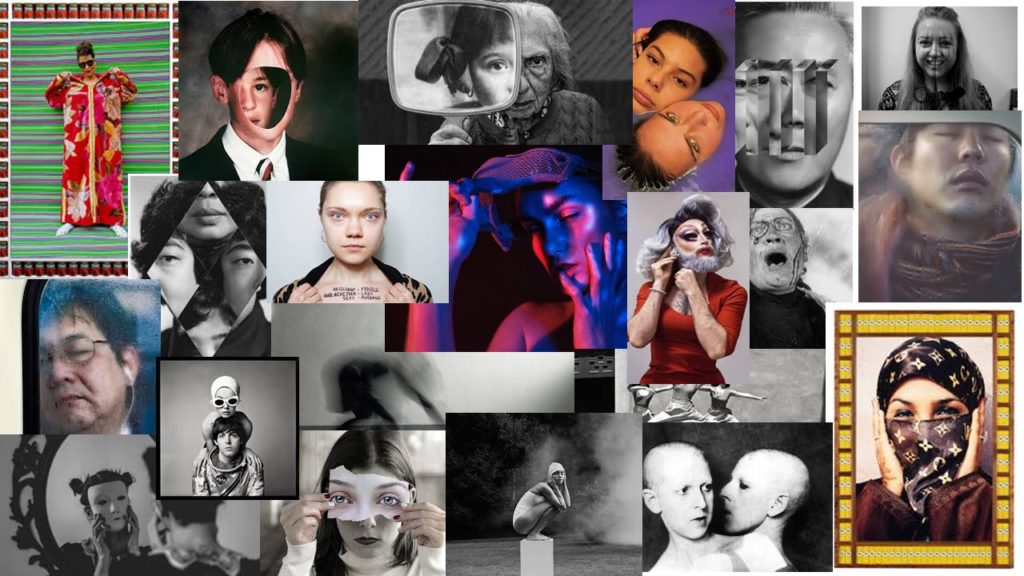
mind map

mood board

mind map


Claude Cahun was a French lesbian photographer born in 1894 in Nantes, France. Cahun’s birth name given to her was Renee Mathilde Schwob, however she changed her legal name to Claude Cahun in 1917. Cahun was most recognised for her activist work repelling gender norms. She moved to Jersey in 1937 with her partner, Marcel Moore (named at birth as Suzanne Malherbe). The couple became active as resistance workers and propagandists during the German occupation of Jersey and the other Channel Islands. Cahun and Moore would attend Germany military events and placed activist leaflets in the pockets of soldiers, on chairs and even hid them in cigarette boxes for soldiers to later discover. Cahun continued to take self portraits presenting herself in non-binary characteristics until her later life, although she did not want to be famous therefore didn’t gain recognition for her photography until she died in 1954, after se and Moore had been arrested and sentenced to death in 1944 due to their activist movements. However before their death sentence, Jersey was liberated in 1945, resulting in both of their releases although Cahun later died due to being poorly treated in prison. Claude Cahun’s writings were published in 2002, as she leaves behind her iconic legacy in the non-binary and LGBTQ community.
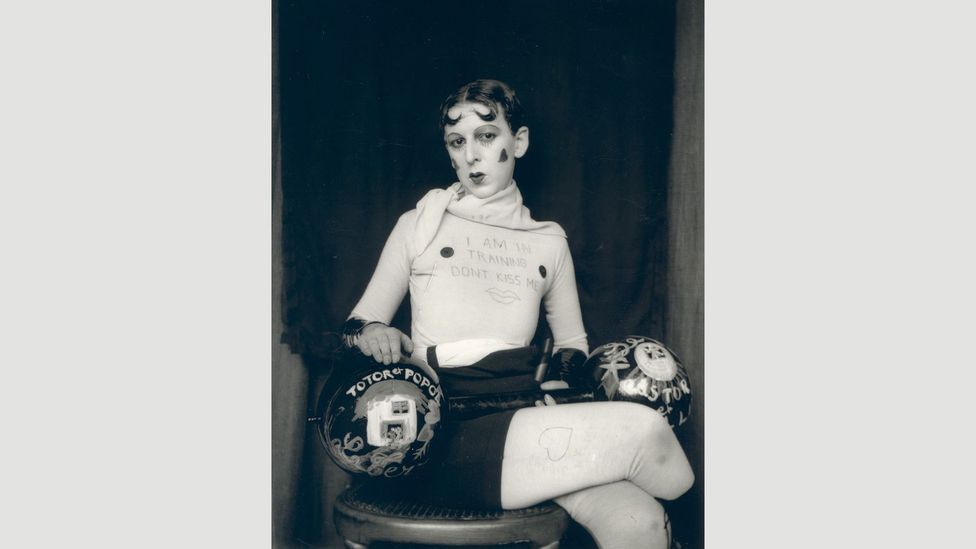
The lighting in the image is rather soft, as it creates subtle shadows which can be seen in the face and especially under the eyes. However the juxtaposition between light and dark is still very intense. This is shown in the clothing, makeup and hair, and how they create an extreme contrast in tone against Cahun’s fair skin. The main source of light appears to be coming from behind the camera, as the face is lit quite evenly.
There is no distinct use of line in this photograph, as there is neither a repetition of line of use of leading lines, which makes the composition more complex.
Similar to the use of line, there is no representation of repetition in this image, presumably to focus on the activist message of the composition of the image.
The majority of the shapes in the image are organic and curved. The only representation of artificial shapes is the rounded weight in the hands of Cahun.
It is difficult to recognise the depth of field in this image as the background is made up of purely empty space, therefore making it difficult to compare the focal point’s focus with the background.
Although texture is not the main focus for this image, the overall texture of the image is rather smooth as the shapes in the photograph are organic and curved. There is no representation of rough or jagged edges.
There is a range of tones from dark to light in this image. The darkest sections of the photograph can be seen in the hair, clothing and makeup of Claude Cahun aswell as the background. The lightest areas are found in Cahun’s fair skin tone and the white images on the weights in Cahun’s arms. The image, overall, tends towards darkness as the entire background and elements of the foreground prioritise darker tones.
There is no colours featured in this photograph as the photo was taken in 1927, and colour photography was only made accessible in the late 1930’s. However I believe the vintage greyscale appearance of the photo adds a sense of intimidation and courage.
The composition of this photograph is very artificial and purposely set up. In the photograph, Cahun dresses as a ‘strong man’ from a circus, in order to create controversy over the stereotypical woman being weak or insignificant. This would have been a risky and revolutionary protest for both women and the LGBTQ community as these groups had been oppressed for centuries, yet Cahun celebrates her differences and sexuality.



An aspect of the theme Identity that I would like to explore and express is that the way you see yourself, whether that’s physically or mentally, and how it differs from all the different ways that others may view you. Each and every person around you view you in a different way than you do yourself, they see other angles, have different memories of how you looked and acted. There are a variety of ways that this message can be conveyed through one or a few images. This can be linked to ‘body dysmorphia’ which is a mental disorder characterized by the obsessive idea that some aspect of one’s own body part or appearance is severely flawed and therefore warrants exceptional measures to hide or fix it (most of the time, only the person sees this flaw and others do not notice it to the extent that the person themselves does)
Approach idea 1: The use of mirrors, glass, plastic to create reflections and or distortions representing viewpoints and angles of how a person is seen or sees themselves.

Approach idea 2: Multi-exposure images to display multiple viewpoints similarly to my first idea.

The definition of identity is who you are, the way you think about yourself, the way you are viewed by the world and the characteristics that define you. An example of identity is a person’s name . An example of identity are the traditional characteristics of an American. Identity has two important features: continuity and contrast. Continuity means that people can count on you to be the same person tomorrow as you are today. Obviously, people change but many important aspects of social identity remain relatively stable such as gender, surname, language and ethnicity. Your identity can be influenced by “place”, such as where you grew up. It is much easier to understand an individuals identity when you realize everyone is a product of their environment, that is why I think that “place” is the biggest influence that shapes your identity and who you are as a person.
Mood Board

Mind Map

Exploring Identity
Photographers that explore identity: Sam Contis, speaks to the idea of community and the social self. Andrzej Steinbach, Paul Mpagi Sepuya, Sofia Borges and Shilpa Gupta. Photographers that explore identity solely through portraiture: Kandara Enyeasi, Cedric Nzaka, Zarita Zevallos, Ussi’n Yala and Thompson S. Ekong.
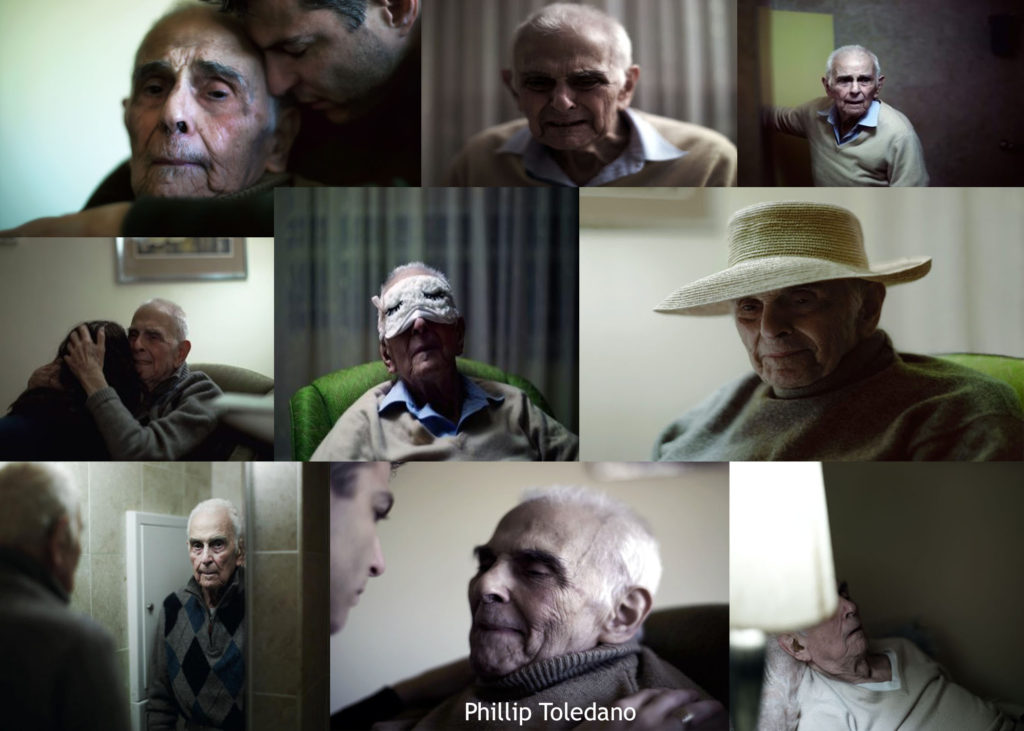
Phillip Toledano’s series ‘Days With My Father’ follows his fathers life after his mother died and how he is coping living without her and dealing with the grief.
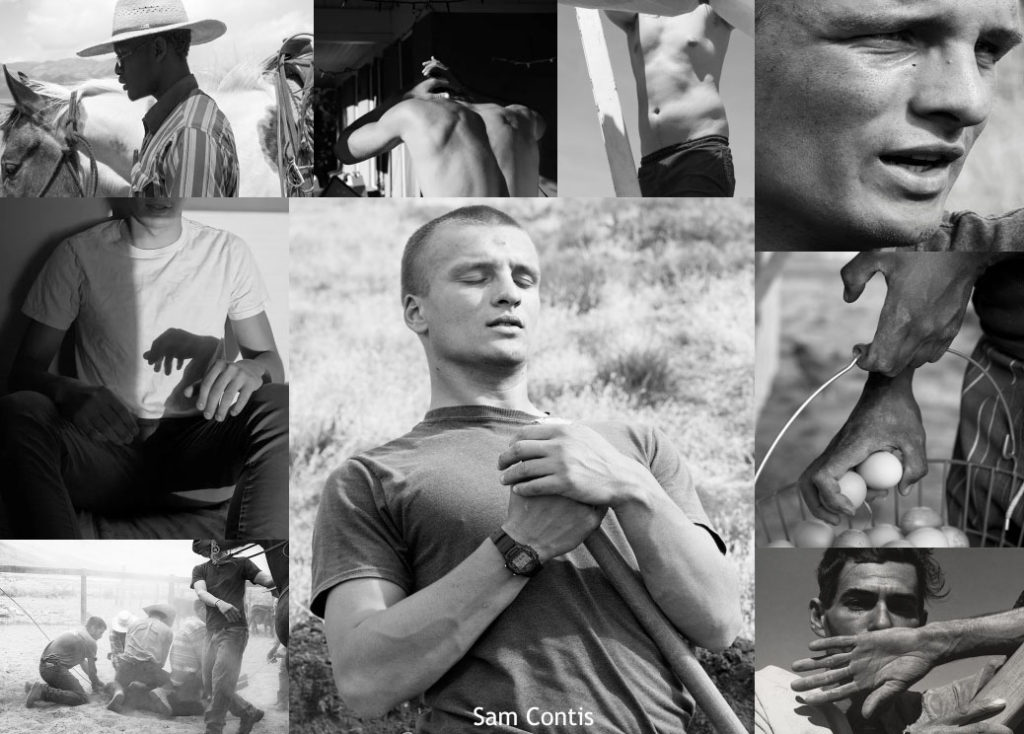
Sam Contis’ series “Deep Springs” speaks to the idea of community and the social self. Contis spent lengthy visits at a traditionally all-male liberal arts college in the high desert of California, a remote backdrop that contrasts starkly with the group mode of collegiate life. “Contis’ subjects are pictured at a moment in their lives – the early college years – that has been typically understood as a time of coming into one’s adult self,” said Gallun. “In this case, such identity-formation is impacted by group social dynamics as well as connection to the characteristic western landscape.”

Zerita Zevallos focuses on the racial aspect of identity with her work. Her work is described as having ‘those unique characteristics of blending the ruthless reality and trauma Black folks go through on a daily basis, while capturing the attention of all gazes towards a narrative far too long ignored’. Her visual composition is simplistic but powerful and elegant, all while using a model presenting a physique long rejected by Western social standards of beauty. I believe that her work, subject and concepts are elegant and so timelessly impactful.
Definition of Identity
“the distinguishing character or personality of an individual”.
How an individual views themselves.
How others view an individual.
Identity can affect people in many different ways and each persons identity can be resultant on their upbringing due to the Tabula Rasa theory which states that individuals are born as a “blank slate” and the people that raise you and the culture of the environment you grow up in mould your identity. People can relate their identity to many aspects of their life – gender identity /cultural identity /social identity /
geographical identity /political identity /lack of / loss of identity.
Intro – ‘Claude Cahun, born Lucy Renee Mathilde Schwob, was a French lesbian photographer, sculptor and writer. Schwob adopted the pseudonym Claude Cahun in 1917 and is best known for self-portraits, in which Cahun assumed a variety of personae.’ – Wikipedia
Claude Cahun explored the idea of identity within lots of her portraits, such as gender/sexuality identity and self identity.
Here is one image that explores self identity and how Claude Cahun felt about her own identity.

This image by Claude Cahun is a double exposure portrait. (Double exposure – the repeated exposure of a photographic plate or film to light, often producing ghost images.) This would have been created by taking an original photograph, then taking another image using the same film that was just used to take the previous image. This creates the effect of the same person having multiple identities as the same subject appears twice in the image. The image is in black and white which creates a strong contrast between the lights and the shadows, adding depth to the image. The use of an un-detailed background also keeps the focus on the subject in the middle of the image.
Intro – ‘My name is Laura and I’m a 24 year photographer and designer from a village in Suffolk, UK. I specialize in fine art portraits and natural, documentary style wedding photography.
I’m a storyteller. I use the art of photography to blur the lines between real life and fantasy to create unusual artworks and surreal worlds.’ – https://laurawilliamsphotography.co.uk/
Laura Williams also has a range of images portraying lack of/loss of identity. These images involve a mirror and a subject, and has been edited to symbolize the lack of the subjects identity –
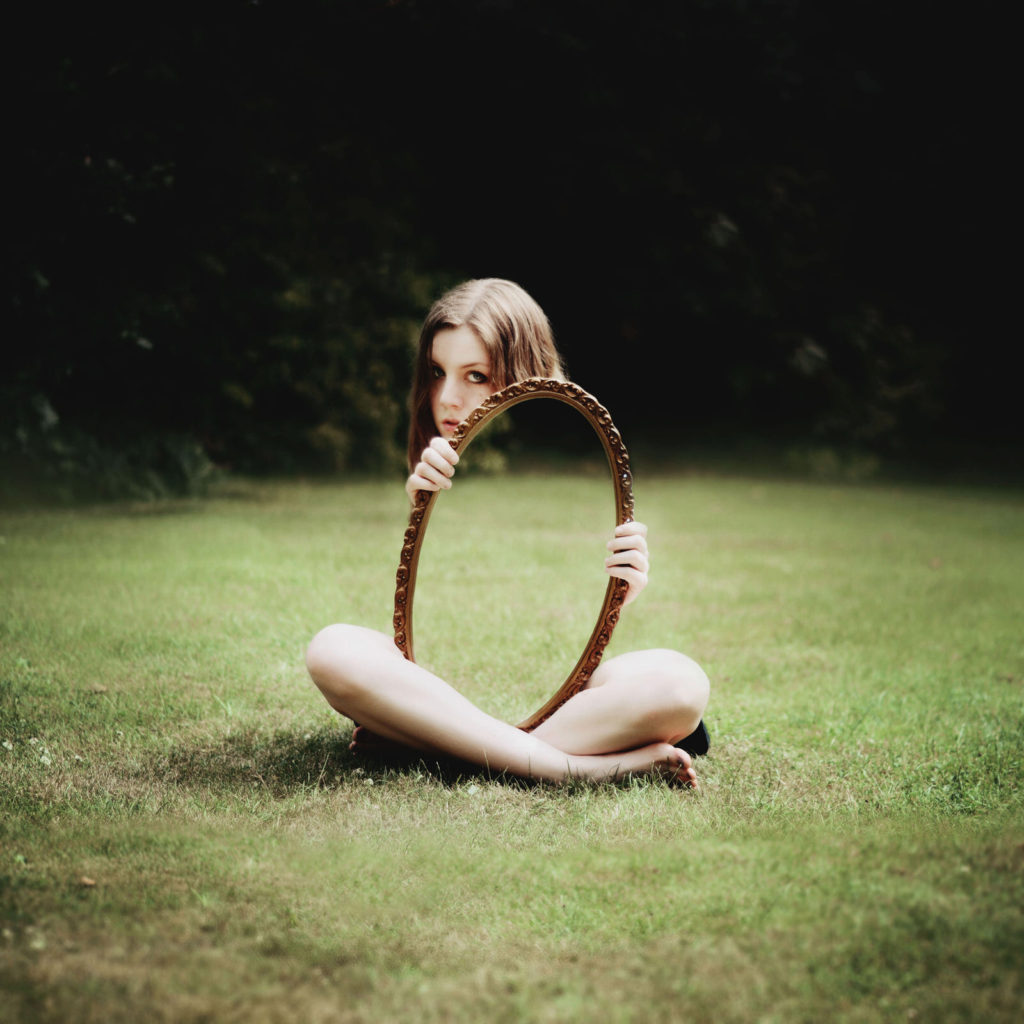
This image by Laura Williams is of a girl holding a mirror sitting in a garden. This image has a shallow depth of field, created by having a wide aperture and focusing on the subject. Similarly to Claude Cahun. this draws attention to the subject in the centre of the image by having the edges out of focus and the centre sharp and in focus. The image has been edited in post to make the mirror being held to have a deeper meaning. Prior to taking the image with the subject in, an image was taken with the same framing but without the subject. This image was used to edit inside of the mirror, creating the effect that the mirror allows the viewer to see through the subject and all the way to the background. This links to the loss/lack of identity as it makes the subject seem as is shes not there. This contrasts to Claude Cahun’s meaning in the previous image becuase her image reflected the idea of having more than one identity, where as Laura Williams created the idea of not having an identity at all.

Identity – ‘the distinguishing character or personality of an individual : individuality : the relation established by psychological identification.’

Identity of a person or group can be influenced by their location, relationships with other, relations with themselves, things that are important to them, your environment or upbringing, gender identity, cultural identity, social identity, geographical identity, political identity, lack of or loss of identity
Lack of or loss of identity is what i am most interested in as i feel i can create photographs with deep meanings and metaphors to do with this type of identity.

Over the course of time, identity has come to mean several different things and people interpret the word in their own unique ways. A dictionary definition of the word will tell you identity is ‘the fact of being who or what a person or thing is,’ however identity is a word that holds many meanings. You may define identity as your culture, where you are from and how you’ve grown up- yet somebody else may have a completely opposite perception of the word such as identity meaning gender, personality or looks. Identity has been explored through photography for decades, it gives an understanding into people’s lives and beliefs by presenting them in their truth, or opposingly in how they want others to believe is true. Frequently, identity is changing and being influenced by our views on the world- some may say your identity is moulded by your surroundings and environment.


Personally, identity is influenced by countless things, but specifically upbringing and family. I like the idea of doing a project focusing on the identities and lives of my grandparents, as they have been extremely influential to me throughout my life and inspire me daily. I plan on documenting certain moments of their day and producing a sequence of images showing how their relationship is so important in their lives and mine. My concept is to demonstrate how family relationships and love can shape someone’s identity and how my grandparent’s past and upbringing has impacted my family today. To experiment with the ‘place’ aspect of this project I plan on experimenting with scenarios around my grandparent’s home as it is a place of safety and security for them, full of memories from over the years and things that bring them comfort. I want to show how identity is not only formed by our perception of our self- it is influenced by past memories of nostalgia and our changing passions in life.
What is identity?
From Latin Identities, identity is the set of traits typical of an individual or a community. These traits characterize the subject or the collective in front of others Identity is also a person’s self-awareness that makes them someone other than others. Although many of the traits that make up the identity are hereditary or innate, the environment exerts a great influence on the shaping of the specificity of each subject; for this reason expressions such as “I am looking for my own identity” are valid. In this sense, the idea of identity is associated with something of its own, an inner reality that can be hidden behind attitudes or behaviours that, in reality, have no relation to the person: “I felt that I had lost my identity; I started accepting jobs that I didn’t like and with which I had nothing in common. “The concept of sexual identity refers to each person’s vision of their own sexuality, which is decisive in relating to the rest of society. Notion links the biological dimension of the human being with the cultural aspect and freedom of choice.

What is Identity?
Identity is who you are and how you became this way. Its how you portray yourself to others, and to yourself. This can be based on anything in your life: culture, upbringing, social identity in person and on the media, gender and sexuality, etc.
Social Identity on the media is commonly very different to your social identity in person. Many people use social media to portray how they would like to be viewed by others, rather than they actually are in person. Just like on social media, our identity can be portrayed through art- it can be difficult to describe yourself in words, so describing yourself through your own creations of colours and shapes can show more than some words can. This also links to any other form of identity.